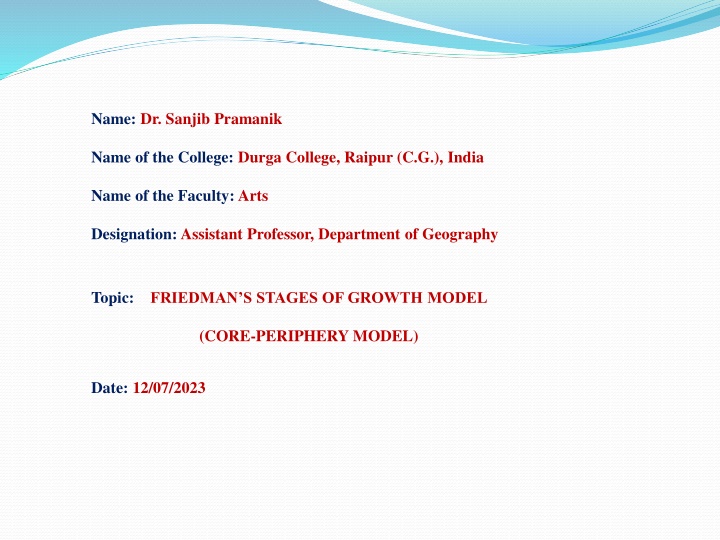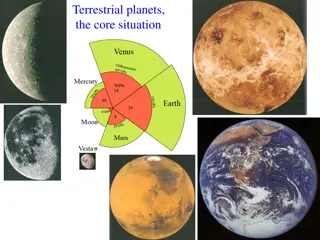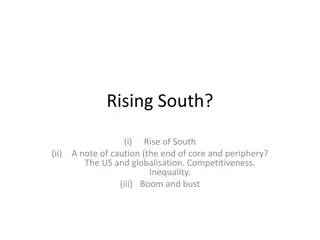Friedman's Core-Periphery Model
The core-periphery model, developed by John Friedmann, explains the spatial distribution of urban development and the emergence of an integrated urban system. It categorizes regions into core, upward transition, resource frontier, and downward transition regions, shedding light on disparities and growth patterns. Explore the stages of growth and their impact on urban areas.
Download Presentation

Please find below an Image/Link to download the presentation.
The content on the website is provided AS IS for your information and personal use only. It may not be sold, licensed, or shared on other websites without obtaining consent from the author.If you encounter any issues during the download, it is possible that the publisher has removed the file from their server.
You are allowed to download the files provided on this website for personal or commercial use, subject to the condition that they are used lawfully. All files are the property of their respective owners.
The content on the website is provided AS IS for your information and personal use only. It may not be sold, licensed, or shared on other websites without obtaining consent from the author.
E N D
Presentation Transcript
Name: Dr. Sanjib Pramanik Name of the College: Durga College, Raipur (C.G.), India Name of the Faculty: Arts Designation: Assistant Professor, Department of Geography Topic: FRIEDMAN S STAGES OF GROWTH MODEL (CORE-PERIPHERY MODEL) Date: 12/07/2023
FRIEDMANS STAGES OF GROWTH MODEL (CORE-PERIPHERY MODEL) Dr. Sanjib Pramanik Assistant Professor Department of Geography Durga College, Raipur
INTRODUCTION The core-periphery model was developed in 1963 by John Friedmann and it identifies the spatical distances from the core. John Friedman is one of the pioneering urban theorists of the late twentieth century. He founded the Graduate School of Architecture and Planning at UCLA in the late 1960. He is famous for his analysis of world city formation.
CORE-PERIPHERY MODEL The core-periphery model of development, tries to represent the emergence of an urban system in four major stages which works equally with the development of transportation. From an initial state of inequalities, disparities are reduced and a functionally integrated urban system emerges. It helps explain why some inner city areas enjoy considerable prosperity, whilst others display all the signs of urban deprivation and poverty. The core-periphery model works on many scales, from towns and cities, to a global scale.
John Friedman proposed that the world can be divided into four types of regions. These are; 1. Core regions 2. Upward transition regions 3. Resource frontier regions 4. Downward transition regions
1. CORE REGIONS Core regions refer to centres, which are usually metropolitan. These centres typically have a high potential for innovation (improvement) and growth. Example: S o Paulo in Brazil.
2. UPWARD TRANSITION REGION Upward transition regions are areas of growth, which spread over small centers, rather than at the core.
3. RESOURCE FRONTIER REGION This region refers to a newly colonized region at the periphery of a country, which is brought into production for the first time.
4. DOWNWARD TRANSITION REGION These regions are on the periphery characterized by depleted resources, low agricultural productivity or by outdated industry. A current Caribbean example of this is in Haiti.
The Model Explained............. Services, investment and jobs are concentrated in the core Central Business District (CBD). Accessible inner city areas may benefit from a trickle down of wealth from the core. For example, in some areas there may be a through-flow of office workers to the inner city seeking low-price lunchtime meals. The core also provides work for inner city residents.
Core-Periphery Model Spread Effects
Less accessible inner city areas may experience a backwash effect, with the little investment that occurs in the inner city becoming concentrated close to the CBD, widening the poverty-wealth gap. This is illustrated in the diagram below, a reversal of the core- periphery model.
Core-Periphery Model Reversal or Backwash
STAGES OF DEVELOPMENT According to John Friedman s theory, there are four stages of development. These include; Stage - 1 Pre-industrial Stage - 2 Transitional Stage - 3 Industrial Stage 4 Post-industrial
Stage: 1 (Pre-Industrial) All the places are peripheral. Place are isolated (Like these bullet points). No interaction between places.
Stage: 2 (Transitional) Development of a core. Interaction between places. Development of basic technology.
Stage: 3 (Industrial) Growth centres (between the core and peripheral) develop. Stable increase in economy. More advanced technology.
Stage: 4 (Post-Industrial) All places are self sufficient. Major interactions. Reduce inequality.
CONCLUSION The model attempts to represent the emergence of an urban system in four major stages. It helps explain why some inner city areas enjoy considerable prosperity, whilst others display signs of urban deprivation and poverty.





















